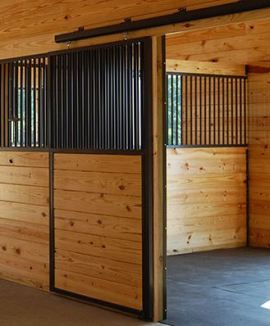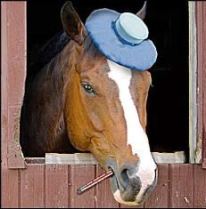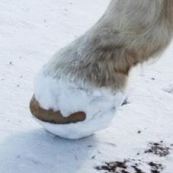 Thinking of remodeling or building a new barn this spring? One of your big decisions (and biggest expense) could be the type of wood you use for your project. There are many types of wood out there and it can be daunting to figure out which one to use. The general answer? It depends on what’s most available in your area as well as your area’s weather condition. Heavy snows may require one type of wood while areas with insect issues might be best with another. Whatever you choose, if you’re building your walls with wood, use pressure treated wood whenever it’s in contact with earth or steel. However, pressure-treated wood should never be placed where horses can get to it.
Thinking of remodeling or building a new barn this spring? One of your big decisions (and biggest expense) could be the type of wood you use for your project. There are many types of wood out there and it can be daunting to figure out which one to use. The general answer? It depends on what’s most available in your area as well as your area’s weather condition. Heavy snows may require one type of wood while areas with insect issues might be best with another. Whatever you choose, if you’re building your walls with wood, use pressure treated wood whenever it’s in contact with earth or steel. However, pressure-treated wood should never be placed where horses can get to it.
There are many horse owners who like the traditional look of a wood when designing their barn. And if you are interested in “going green,” often wood barns provide a much smaller environmental footprint than those made with other materials. Wood is also a natural insulator so is an excellent choice for areas where summer heat and winter cold temperatures are extreme.
When researching the best wood for your barn, look for lumber that has a high-bending strength, good nail holding power, moderate shrinkage, decay resistance, withstands splitting, good painting and weathering qualities, freedom from warping and is easy to work with.
Classic Equine Equipment keep in stock premium imported hardwood and Southern Yellow Pine. Both types are milled to their exacting specifications – including a tongue and groove as well as a v-notch on the face of each board. Additional types of wood are also available upon request. Wood is sold separately.
Tongue and groove wood material for your stall lining is one of your best options because it’s flush and there are no ledges. Some horses find chewing on wood an amusing pastime. But there’s a possibility of splintering and chemical ingestion. Keep your barn looking good and your horse safe by eliminating opportunities to chew.
 Their Brazilian hardwood is 1” this and comes in 12” increments. A true hardwood, it is very dense and durable. Although no wood can be considered “horse proof”, the strength of this wood is exceptional.
Their Brazilian hardwood is 1” this and comes in 12” increments. A true hardwood, it is very dense and durable. Although no wood can be considered “horse proof”, the strength of this wood is exceptional.
The Southern Yellow Pine comes in 2”x 8”x 12’ lengths. It is #1 or better premium wood – no warping, stains, stamps or discolorations. Although not as dense as the hardwood, this is the strongest of the “softwoods” and is a very popular choice for horse stalls.
 HDPE (High Density Polyethylene) uses primarily recycled post-consumer plastic with a positive environmental impact to create a long-lasting, no maintenance and weather resistant material. HDPE is UV resistant, easy to maintain and does not require staining. It comes in a variety of lengths and colors.
HDPE (High Density Polyethylene) uses primarily recycled post-consumer plastic with a positive environmental impact to create a long-lasting, no maintenance and weather resistant material. HDPE is UV resistant, easy to maintain and does not require staining. It comes in a variety of lengths and colors.
Many barn builders use high-grade 90% Spruce J-Grade logs. The lumber is uniformly seasoned in dry kilns which improves strength and stiffness. It also enhances its appearance and increases its resistance to decay and insect attack. It can be used for all aspects of barn building, including a log siding.
Red cedar is another option for your barn. However, the oils in cedar that help protect it are extremely enticing to horses. They love to chew on cedar wood so confine your use of cedar to the outside of the barn. While beautiful, it is not as structurally strong as other types of wood.
Bamboo is one of the fastest-growing plants on Earth, with reported growth rates of 39 inches in 24 hours. Bamboo is best used as flooring in the tack room, your office or in the barn club house.
Be as picky with your choice of lumber as you are with the rest of your barn design. Low grade wood may look just fine when you put it in, but five years later you can have problems. Like most everything else, you get what you pay for.


 PULSE:
PULSE:  This year, nearly all of the country is being hit with some sort of snowfall. Riding in the snow is one of winter’s joys and is a nice change for your horse.
This year, nearly all of the country is being hit with some sort of snowfall. Riding in the snow is one of winter’s joys and is a nice change for your horse.  This wetter, icier snow is a prime cause of “ice balls” in your horse’s hoofs. When your horse walks on snow, the heat of his hoof can warm up the snow while it touching the metal horseshoe can make it freeze again, causing a buildup. After a while, this turns into an uneven mass that can cause your horse discomfort when walking and even real damage to tendons and joints. There are several ways to help prevent this problem. They include letting your horse go barefoot, using hoof boots or adding anti-snowball pads.
This wetter, icier snow is a prime cause of “ice balls” in your horse’s hoofs. When your horse walks on snow, the heat of his hoof can warm up the snow while it touching the metal horseshoe can make it freeze again, causing a buildup. After a while, this turns into an uneven mass that can cause your horse discomfort when walking and even real damage to tendons and joints. There are several ways to help prevent this problem. They include letting your horse go barefoot, using hoof boots or adding anti-snowball pads.